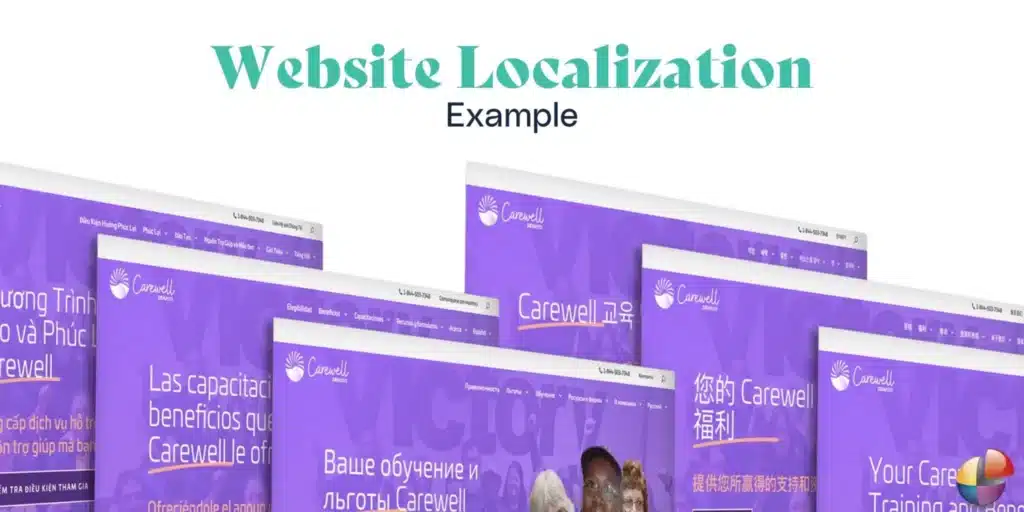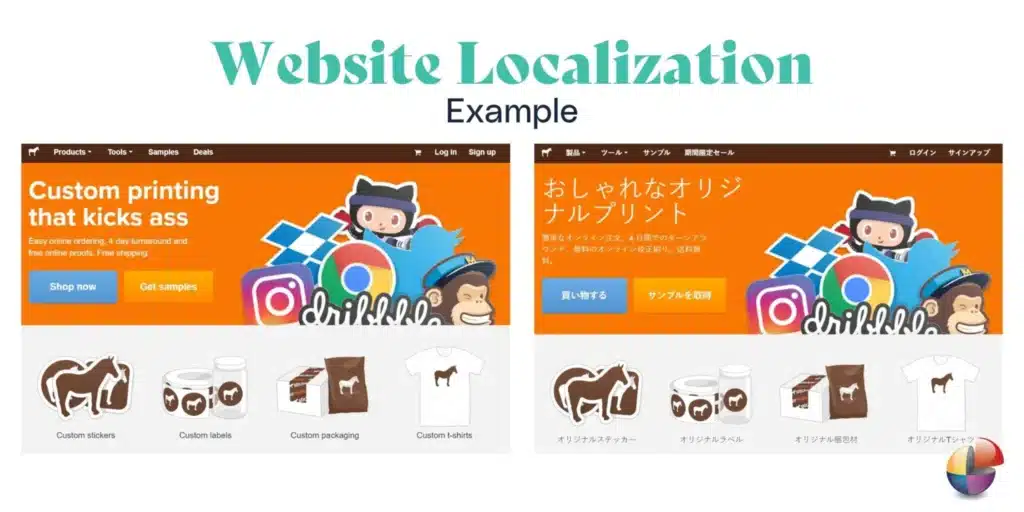
Website localization adapts content to target global markets. Learn what is website localization and the best practices, potential pitfalls, the process (with examples).
Website localization is the key to increasing sales for any global industry, such as e-commerce, manufacturing, finance, travel, or tourism. With nearly 5 billion internet users worldwide, you will miss out if you don’t adapt your content correctly. Providing your non-English-speaking audiences with an exceptional website experience shows your brand’s commitment to serving all your markets (and increases global sales).
Topics covered in this article:
- What is Website Localization?
- Website Localization vs Translation
- Why is Website Localization Important
- How to Localize a Website: 3 Steps to Prepare for a Global Website
- Localizing User Experience
- The Website Localization Process
- Website Localization Best Practices
- Website Localization Examples
- Mobile App Localization
- Web Proxy Translation
- AI Translation for Websites
What Is Website Localization?
Website localization is adapting your web content to be culturally relevant. It takes website translation a step further by considering the specific market’s culture in addition to the market’s language.
Localizing your website would consider adjusting:
- Verbiage, tone, and language nuances to meet the culture and preferences of the target language
- Units of measurement
- Currency and payment systems
- Phone numbers
- Banners, graphics, icons
- Navigation menus, website forms, and landing pages
- Displayed product content descriptions
- Video and audio content
- PDFs and eBooks
- eLearning courses
Website Localization vs Translation
Website localization adapts and modifies the source document to the local cultures or regions you’re aiming to target. Website translation is the practice of using the same words and the same content, only transcribed into another language. Translation is only one of the several elements of the localization process.
Learn more about translation vs localization and how to adapt your English files for the localization process.
Why is Website Localization Important?
Gain a Competitive Edge with Site Localization
Translating a website isn’t enough. Nothing turns away potential customers like making them feel your site is unprofessional with grammatical errors, mistranslated words, and incorrect cultural references. Website localization creates a culturally authentic experience.
To expand your business globally and succeed internationally, you must invest in accurate and professional website localization.
It tailors your site to the culture and language of your target market, enhancing user experience and engagement. Localizing your web and mobile apps makes your content more accessible and relevant, helping you stand out in the global market. By leveraging website localization services and following best practices, you can build a strong international presence and attract a diverse customer base, ultimately ensuring you stay competitive in the marketplace.
Build Trust with New Markets Through User Experience
Local markets expect a website experience tailored to native speakers. Studies show that 55% of global consumers would only buy from websites written in their language. A whopping 87% of them would never buy from an English-only website! If this is how consumers feel about language, imagine how much trust and goodwill you can build by accurately localizing your website.
Take the financial industry, for example. Banking in Brazil is challenging, and credit is notoriously tricky to obtain. The message will not be effective if you are mentioning financial staples that are not common to the target audience. Website localization can consider the challenges of each market and deliver an experience that matches your expertise.
When your site speaks the language and reflects the cultural nuances of your target market, it shows that you understand and respect their unique needs and preferences. This cultural sensitivity fosters a sense of trust and connection, making potential customers more likely to engage with your brand. By localizing your website and content, you demonstrate commitment and authenticity, which are essential for establishing a strong, trustworthy presence in new markets.
Increase Your Bottom Line by Driving Revenue and Growth
Adapting your user interfaces and web content to your specific market’s language allows increased access and increased sales. Ultimate good sales and marketers know that building trust in your audience’s language will increase their loyalty and repeat business. Maximizing your search results will bring more potential consumers to your site and increase sales. If sales are your focus, you should be committing to accurate website localization.
How to Localize a Website: 3 Steps to Prepare for a Global Website
The best way to localize a website is to prepare with research and then use a professional translation company.
1. Identify Demand
To successfully localize your website or product, start by identifying the demand for your offerings in new markets. This involves a multi-faceted approach:
Survey: Conduct surveys to gauge interest and gather insights from potential customers in your target markets. Surveys can provide valuable data on consumer preferences, expectations, and pain points.
Internal Discussions: Engage with internal teams like marketing, sales, and customer support. These teams often have firsthand knowledge of customer interactions and feedback, which can reveal demand patterns and regional needs.
2. Market Research & Keyword Research
Effective localization requires thorough market and keyword research to ensure your product or service resonates with the new audience. Here’s a detailed approach:
- Languages and Dialects: Identify the languages and dialects spoken in your target markets. Consider not only the primary language but also regional dialects and variations that could affect localization.
- Regional and Cultural Nuances: Research cultural nuances and regional preferences. For instance, color meanings, imagery, and even humor can vary significantly across cultures and can impact how your content is received.
- Product Benefits: Assess how your product or service benefits the new audience. Tailor your messaging to address specific needs or desires unique to that market. For example, a fitness app might emphasize different features based on regional health trends.
- Modifications: Determine if you need to adjust your product, offering, price point, messaging, or brand to better fit local expectations. This might include tweaking features to align with local preferences or adjusting pricing strategies to match local purchasing power.
- Keyword Terms and Phrases: Perform keyword research to identify terms and phrases your new audience is searching for. Just as British and American English use different terms (“vacations in Orlando” vs. “holidays in Orlando”), other languages also have regional variations. For example, in Spanish, “apartamento” might be used in Spain while “departamento” is common in Latin America. Understanding these differences ensures your SEO strategy aligns with local search behaviors.
A Note About SEO Localization
If you work in Marketing, you know that search engine optimization (SEO) is a huge component of driving web traffic (and sales). If you don’t work in Marketing, SEO is the process of using keywords and phrases related to your product in your web content. This helps people find the services and products they are looking for on your site.
However, SEO keywords and phrases may not translate appropriately if exchanged word-for-word. Using human translators to localize your content will naturally help improve SEO in other countries.
Some research is required to determine the best keywords and phrases to use in different markets. But the extra work will pay dividends when your global customers can quickly locate your site as an expert source.
3. Create Your Localization Team
Building a strong localization team is crucial for a successful localization strategy. Y
Your internal team should include:
- Internal Stakeholders: Identify who on your team will be responsible for communicating the company’s needs with the translation agency and others who should be involved in the process.
- Content Reviewers: Have team members that are fluent in the target language review sample translations or the final translation product to ensure quality meets your standards.
Your external team should be a localization agency that has the following:
- Localization Project Manager: Oversees the localization process, ensuring timelines and quality standards are met.
- Linguists and Translators: Experts fluent in the target language, with knowledge of regional dialects and industry-specific terminology.
- Multilingual DTP Specialists: Adapts images and document formatting for different languages and cultural preferences.
- Localization Engineers: Handle the technical aspects of website localization, such as adjusting code and ensuring compatibility with different languages and platforms.
Localizing User Experience
Localizing the user experience is a comprehensive process that goes beyond mere translation of text. It’s about creating a seamless and intuitive experience for users in different regions, ensuring that every aspect of your site or application resonates with local audiences. To achieve this, you need to focus on several key areas:
- User Interface (UI): Adapt UI elements to accommodate different languages and cultural preferences. This includes adjusting layouts to handle varying text lengths and formats.
- Content Relevance: Ensure that all content, including images, videos, and graphics, is culturally relevant and resonates with the local audience. For example, imagery that works in one culture might be inappropriate or confusing in another.
- Navigation and Functionality: Test and adjust navigation and functionality to ensure they are intuitive for users in different regions. This includes checking that all interactive elements are easily accessible and user-friendly.
The Website Localization Process
If you’re ready to take on the website translation and localization process, we highly recommend consulting with a professional translation company. There are many things that can go wrong in the process, and website translation is rarely a one-and-done project. Websites are often evolving, and you need a translation partner with an agile translation process that can keep up with translating new content as well as updating existing web pages.
We cover how we recommend choosing a translation company and the entire process from understanding industry terminology to interviewing potential agencies and the entire process.
But the basic steps of what to expect from a website translation process is:
- Localization Strategy – ensure your web team and your translation agency are a good match
- Delivering File Formats – provide the translation agency website files, exports, or access to cloud-based content. Files are engineered and prepared for localization and scope is analyzed. This ensures an accurate translation cost and delivery schedule.
- Kickoff Call – meet the rest of your team. Depending on the size of the site and the number of languages, you might have multiple project managers, engineers, or a multilingual DTP specialist helping localize your site.
- Service Match and Translation-Revision-Proofreading (TRP) – this is where professional linguists translate, revise and proofread all content
- Final Quality Assurance (QA) – Translated language files are uploaded to a staging site for QA. The website is QAd and tested page by page with the source language site.
- Delivery – The final website is delivered.
- Personalizing the Translation Process – This process will be adjusted further for custom sites with more detailed content such as eLearning courses that need to be localized, SaaS translation, or extensive accessibility requirements.
Website Localization Best Practices
You should have a clear understanding of website localization and the steps your translation agency will guide you through. But what are the best practices of going global?
To ensure the success of your website localization efforts, here are our extra guidelines that will help you avoid common pitfalls and set your project up for success.
Using the Same Playbook For Different Countries: While it might be tempting to apply the same strategies across different markets, each country has unique cultural nuances. Tailoring your approach to fit the local context will show respect for your new audience and ensure better engagement.
Assuming the Same Percentage of Early Adopters: Market dynamics vary greatly. Just because a strategy worked with early adopters in one region doesn’t mean it will elsewhere. Researching and understanding the specific market segment you’re targeting will yield better results.
Underestimating the Importance of Brand: In Japan, for example, brand reputation carries significant weight. Investing in building and maintaining a strong brand presence is essential for gaining trust and loyalty from Japanese consumers.
Hiring Based on English Proficiency Instead of Talent: While English proficiency is valuable, hiring individuals who understand the local market and have relevant skills will benefit your localization efforts more. Their insights and expertise can drive more authentic and effective localization.
Neglecting to Build Trusted Local Partnerships: Establishing partnerships with local businesses and influencers can greatly enhance your credibility and reach within a new market. These relationships can provide valuable local insights and support.
Under-Funding Local Teams and Efforts: Adequate investment in your local team is crucial. They are your on-the-ground experts who understand the market’s needs and can adapt strategies effectively. Ensuring they have the resources they need will drive better results.
Not Showing Commitment to the Market: Demonstrating a long-term commitment to a new market builds trust and confidence among local consumers. Quick, short-term efforts might not resonate as well as sustained and dedicated involvement.
Forgetting to Allocate Time for Quality Hires: Hiring the right talent takes time. Plan for extended timelines to find and onboard individuals who align with your company’s values and understand the local market dynamics.
Underinvesting in Live Events and Networking: Face-to-face interactions are invaluable for building relationships and trust. Investing in local events and networking opportunities can provide a deeper connection with your audience and valuable market insights.
Not Adopting a Long-Term Mindset: Quick returns are tempting, but real success in a new market requires patience and a long-term strategy. Building a strong presence and fostering loyalty takes time and consistent effort.
Relying Solely on AI Translation: While AI tools are advancing, they cannot yet replace the nuanced understanding of human translators. Human expertise ensures that translations are culturally relevant and accurate, providing a better user experience.
By embracing these best practices, you can navigate the complexities of website localization with greater ease and effectiveness. Remember, successful localization is about more than just translating content; it’s about creating an authentic, engaging experience for your new audience.We’ve warned about solely using AI-driven translations. The same warnings apply to website localization.
Website Localization Examples
WordPress Localization & Content Localization Services
One example of a website that Interpro translated and localized into 6 different languages.
eCommerce Localization Example
For example, Interpro localized Sticker Mule’s eCommerce website. Let’s look at how an eCommerce website would localize its site to increase sales with Japanese-speaking users.
User interfaces and web content can be translated into Japanese, but a translation agency with website localization services will also consider other adaptations. A website localization strategy can include:
- Incorporating Japanese phrases and mannerisms into your site content and downloadable resources;
- Providing Japanese captions and voiceover audio to your video content (or even recording new videos with the Japanese versions);
- Using images that are culturally sensitive and relevant;
- Setting up date and time formats and units of measurement as preferred in Japan;
- Listing prices in Japanese yen;
- Adapting sales to align with local and cultural holidays as appropriate;
- Ensuring shipping options to Japan;
- Employing Japanese-speaking customer service and local phone numbers; and
- Adhering to Japanese laws and customs when developing the website and user interactions.
Localizing the website will provide an authentic user experience. Your audience should never know the website was translated from English. This will make your customers feel valued and make your company look professional globally.
Mobile App Localization
When choosing a website localization agency, it’s crucial to consider whether you also need mobile app localization and or web app localization. Ensuring your translation company offers both alongside localizing your website offers a consistent user experience across all digital platforms.
Mobile app localization often involves unique challenges, such as adapting interfaces for different screen sizes and optimizing app functionality in various languages. A team experienced in both website and mobile app localization can provide a cohesive strategy that integrates seamlessly across your web and mobile platforms.
By working with a single agency that offers both services, you streamline communication, maintain consistency in branding and messaging, and benefit from their holistic understanding of your localization needs. This comprehensive approach helps deliver a unified user experience, boosts engagement, and maximizes your global reach, ultimately supporting your business’s growth in international markets.
Web Proxy Translation
It should be noted that even experts might use some form of technology to assist with expediting the translation process. Interpro can employ Web Proxy translation services in this way. This may be a fit depending on the volume of anticipated website updates required. It is not the right fit for all situations; Interpro can discuss the pros and cons together with you if Web Proxy solution be of interest.
AI Translation for Websites
Additional caution when looking for a website localization service: beware of any website localization services that offer “instant” or “automatic” localization. Localization cannot be done professionally by artificial intelligence and, therefore, is not something that can be automated or instant.
Working with an experienced translation agency specializing in localization and working with human translators is the only way to ensure a natural, authentic human experience.
Interpro has teams of experts who can translate your copy and localize your messaging, so your audience can identify with it. Any cultural language nuances can be incorporated into the language and culture of your choice.
Ready to localize your website?
You should be ready to begin localizing your site and choosing a translation partner to help you go global.
As you embark on your localization journey, remember that success lies in thorough research, strategic planning, and partnering with experienced localization experts. Embrace the process, and watch your business thrive on the global stage.
Category: Localization
Service: Website Translation
Don't forget to share this post!
Stay Updated with Interpro
Subscribe to our newsletter for the latest updates and insights in translation and localization.









